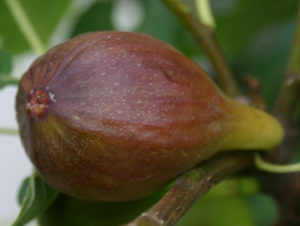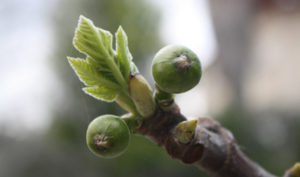By GARY ALLEY
November 2014
Deuteronomy is a book of expectations. In this final book of the Pentateuch, God stokes the Israelites’ expectations concerning their entrance into the long-awaited “Promised Land”, while at the same time, He explains the rules that they are expected to follow. One of these expectations is the agricultural bounty of the land of Canaan, often summed up by the so-called seven species. During the time of Jesus, only these seven varieties[1] were presented in the Temple at Jerusalem as offerings of the first fruits festival (Ex 34:26).
“For the Lord your God is bringing you to a good land, a land of brooks, springs, and fountains flowing forth in valleys and hills, a land of wheat, barley, grapevines, figs, and pomegranates, of olive oil and honey (Dt 8:7-8).”
The FIG is a large tenacious tree which bears a fragile, highly sweet fruit in the hot summer months. The fig, or te’ena in Hebrew, is native to Israel and the Ancient Near East and is well known in many biblical accounts. It is one of the first trees mentioned in the Bible when Adam and Eve used its large, uniquely shaped leaves to sew for themselves coverings.[2] The fig tree’s huge leaves fall away with winter and slowly begin budding forth in spring time. 
In the summer, a fig tree’s leafy canopy provided a comfortable shelter from the blazing sun. The shade of a fig tree was used by rabbis, like Akiva, when teaching their students.[3] Perhaps, Nathaniel was studying in its shade when Jesus first saw him.[4]
Along with grapes and pomegranates, figs were a common fruit associated with the land of Canaan.[5] Figs were often dried and stored as “fig cakes”[6] which extended their shelf-life as food. They were especially beneficial for tired travelers.[7] Sitting under or eating from one’s fig tree was a biblical idiom for “peace and security,”[8] while the fig tree’s decline or destruction was an allusion to desperate, insecure times.[9]
When cultivated for its fruit, the fig required consistent care.[10] In order to reap a bountiful harvest, some types of fig trees, like the sycamore fig (Hebrew: shikma), needed to be pierced by the farmer to allow for fertilization.[11] During harvest season, a fig tree's unpicked fruit needed to be checked daily to prevent rot and theft. Besides being a cattle owner, the prophet Amos was also a fig-pricker.[12]
Amos was a poet as well. Probably, because of the fig’s summer picking season, another name for figs found in the Bible is “summer fruit” or kaytz. This Hebrew word, kaytz, also means “summer” and shares the same root and sounds very similar to the Hebrew word for “the end” (ketz). Like all the biblical prophets, Amos often utilized poetry and alliteration for his prophetic delivery. He expounded a vision given to him by the Lord where a basket of figs, or summer fruit (kaytz), alluded to the end (ketz)—the destruction of Israel.
The sovereign LORD showed me this: I saw a basket of summer fruit.
He said, “What do you see, Amos?”
I replied, “A basket of summer fruit (kaytz).”
Then the LORD said to me, “The end (ketz) has come for my people Israel!
I will no longer overlook their sins.” (Amos 8:1-2)
One of Jesus’ most famous prophetic teachings also alludes to the fig’s relationship to “the end” and judgment. Jesus taught that when the fig tree buds, one knows that summer is approaching and its fruit will be ripe for picking. The fig is a seasonal reminder that God’s judgment does not tarry.
Learn this parable from the fig tree: Whenever its branch becomes tender and puts out its leaves, you know that summer is near. So also you, when you see these things happening, know that it is near, right at the door. (Mk 13:28-29)
[1] Mishna Bikkurim 1,3
[2] Gen 3:7
[3] Midrash Rabbah Ecclesiastes 5:11
[4] John 1:47-51.
[5] Num 13:23; Neh 13:15
[6] Fig cake in Hebrew is devela (see 1 Sam 25:18; 30:12; 2 Kgs 20:7; Isa 38:21; 1 Chr 12:40)
[7] 2 Sam 16:1-2; 1 Sam 25:18-35; 1 Sam 30:11-12
[8] I Kgs 4:25; 2 Kgs18:31; Isa 36:16; Mic 4:4; Zech 3:10
[9] Jer 5:17; 8:13; 48:32; Hos 2:12; Joel 1:7, 12; Amos 4:9; Mic 7:1; Hab 3:17; Hag 2:19; Ps 105:33
[10] Pr 27:18; Lk 13:6-9
[11] In the wild, the young figs were pierced by the fig wasp.
[12] In Amos 7:14, it says that Amos boles shikmim (Hebrew). Most English translations say Amos cared for, gathered, dressed, trimmed, grew, picked, or plucked sycamore figs. The true meaning of boles is to prick or gash the sycamore fig to help it mature and ripen.
![]()
